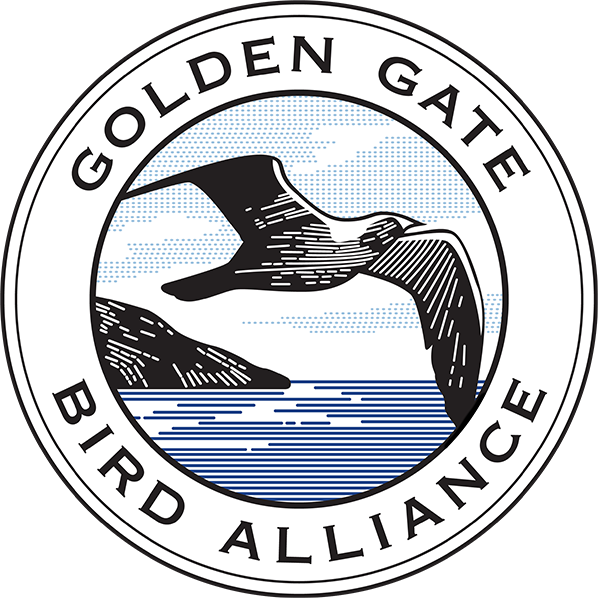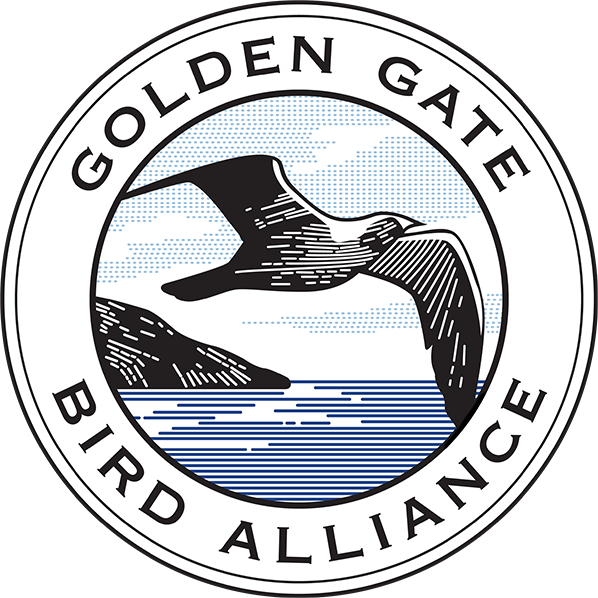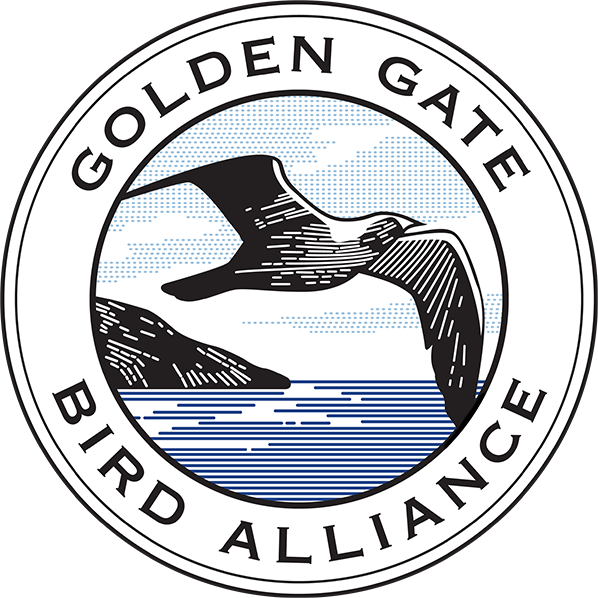Founded in 1917, Golden Gate Bird Alliance engages people to experience the wonder of birds and translate that wonder into conservation action. We offer over 150 free bird walks each year, monthly guest speakers, and volunteer opportunities restoring habitat, educating young people, and engaging in conservation advocacy and citizen science. See our website or sign up for our email newsletters to learn more.
Frequently Asked Questions
(Traditional)
Home of
Rosie and Richmond
Check out our new Chronological FAQ!
Photos and Videos
Photos & Videos
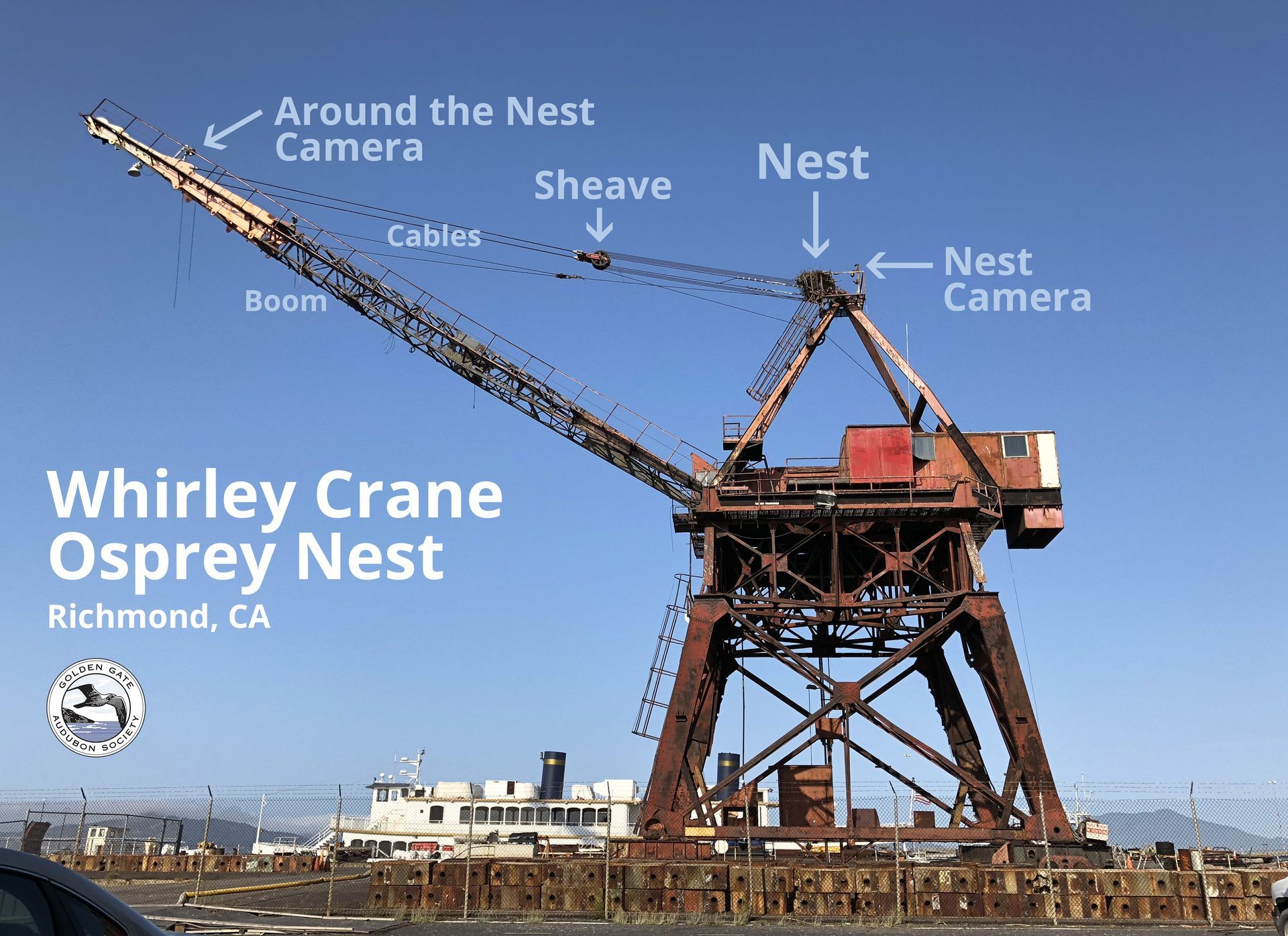
Photo diagram of Whirley crane with nest/cam locations
- See historical and current videos at the SF Bay Osprey’s YouTube channel.
- Wondering what the ospreys will do when? See our Season Schedule.
- Map of local nests.
- Fact sheet about each year’s offspring at this nest.
Many photos and gifs, as well as detailed information, poems, and extensive background about this Osprey nest and its inhabitants over the years, can be found at www.poetsinthegarden.com/fly-with-the-ospreys.
Introduction to Ospreys
Why are Ospreys nesting on a crane?

Ospreys usually select a nest alongside water – rivers, lakes, coasts, or, in this case, San Francisco Bay. A high location is safe from predators on the ground and also provides the Ospreys a great view of the surrounding feeding areas and potential predators in the air. In some cases, where no nest sites are available near their foraging areas, Ospreys may may nest some distance away, where suitable nest sites occur, and must commute considerable distances to hunt. Traditionally, Ospreys usually nested in trees, but in urbanized shorelines they often use human-made structures such as this historic Whirley Crane, as well as light towers, power poles, channel markers, and artificial nest platforms
Do Ospreys mate for life?
One Osprey male and one female typically build a nest and raise young; this kind of pair is called monogamous. There are also records of one male with two females on nearby nests, which is referred to as polygyny. Unless individual birds are banded by scientists, it’s difficult to tell if the birds on a nest are the same birds as last year, but now that we’ve had several years to watch closely, we are confident that the same two Ospreys have nested here since the cameras were installed in 2017.
How can you tell the male and female adult Ospreys apart?
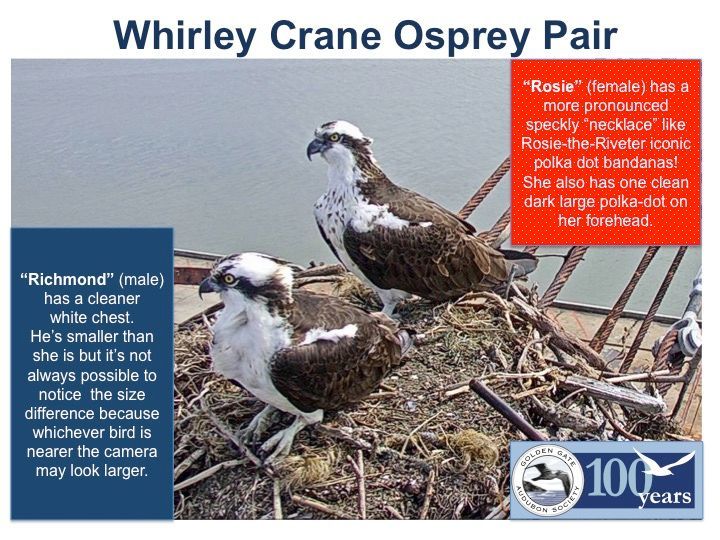
Because of the web camera, we have close up views of the pair that has bonded and been defending the Whirley Crane’s nest. The female is larger but whichever adult Osprey is nearer to the camera might look bigger. They both have markings on their forehead. The male’s forehead markings are sort of smudgy but the dark mark on the female’s forehead mark like one prominent polka dot or a raindrop shape. The female has more dark speckly markings around the front of her chest, which is known as a female Osprey’s “necklace”. We’ve named the female Rosie, which you can remember because she has one big polka dot on her forehead and a bunch of dots on her chest, reminiscent of the iconic Rosie the Riveter bandanas! The male has been dubbed Richmond, in honor of the city to which he’s loyal.
Here’s a snapshot view that shows the differences. Click the photo to enlarge
When is Osprey nesting season? How long does it take for eggs to hatch?

Nesting season typically starts in February and goes through August. Both parents incubate the eggs — about 36-42 days from when they are laid until they hatch. Osprey chicks spend a very long time in the nest after hatching. Their first flights usually occur about 55 days after hatching. However they continue to use the nest for roosting and feeding for a considerable time after that. Fledglings from this nest have been seen on the nest and in the area for 90 to 125 days after hatching, or one to two months after first flight.
What do the different Osprey calls mean?
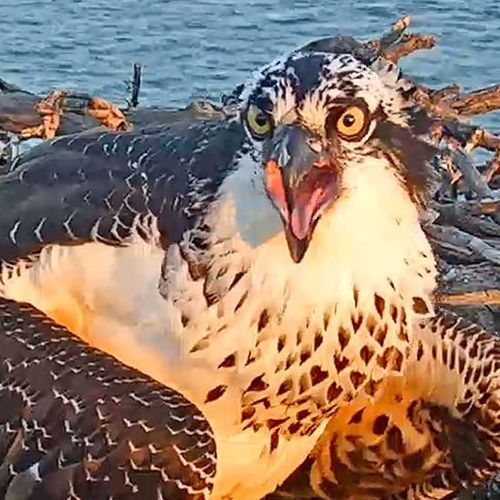
There are three main calls likely to be heard at this nest.
Solicitation Call (first 30 sec of https://macaulaylibrary.org/asset/229102) The most common call, normally given by the female, although rarely by the male. It is often presumed to be urging the male to provide fish. However, the association with this call and fish deliveries is uncertain. As the male approaches with a fish, the calling rises in pitch and becomes more “excited”.
Guard Call (https://macaulaylibrary.org/asset/89000911) Given by both male and female when they observe another Osprey in the area that they perceive to be a possible interloper. This may be given even when Ospreys are merely flying over. If the interloper continues to approach the nest, the calling becomes more intense, like a squeal. Either the male, female or both may eventually take off to chase the interloper away.
Alarm Call (https://macaulaylibrary.org/asset/112235821) Given by both the female and male when a possible predator (non-Osprey) or disturbance (human, boat, automobile) approaches. It may intensify, as the threat comes closer. Eventually, the Ospreys may take off from the nest or perch, and either fly around overhead or at the “predator”. This is important for in-person Osprey nest watchers to learn! Ospreys will let observers know when they are too close. If you hear, see this behavior, move further away until it stops.
Escalated Alarm Call This is an example of Rosie calling during a banding session. The clicks indicate an escalation of her alarm. If you hear or see this behavior, move further away until it stops, or even leave the area completely.
How many eggs and chicks do Ospreys usually have?
A female Osprey typically lays three or sometimes four eggs. Not all the eggs may hatch. The chicks that hatch later may not survive if the parents cannot find enough food to keep all their young well-fed.
How do the young Ospreys learn to fly? Are they in danger of falling out of the nest?
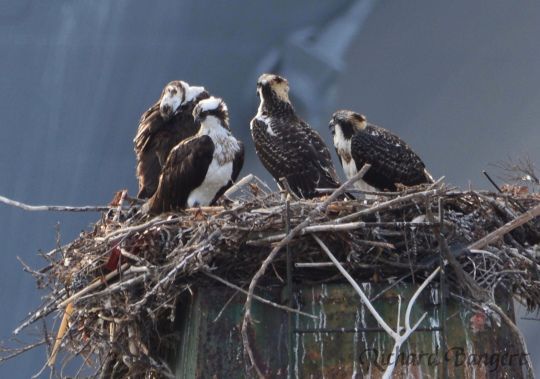
Young Ospreys practice moving in the nest, then spreading their wings and jumping into the air to hover briefly. They often prepare to fly by frequently flapping their wings, providing exercise for strengthening of their flight muscles. Young Ospreys have an instinctive impulse to fly and hunt for fish. However, until they are self-sufficient at hunting, the parents will continue to provide them fish.
There is a risk that young Ospreys may tumble or be knocked out of the nest before they can fly. However, there’s almost always at least one parent at the nest to protect the young before they’re ready to fledge. Parents sometimes entice the fledglings to practice flying by offering a meal that the youngster has to fly to reach. At this nest, there is a platform about 3.5 feet below the nest (“The Basement”) which is below about half of the nest, and several nestlings have spent some time there when they are first learning to fly.
Where do the adult and juvenile Ospreys go when nesting season is over?
We don’t know where our Bay Area adult and juvenile Ospreys go after August, but we’d love to learn more about their migratory routes and destinations! Many studies have been done on East Coast Osprey populations, but fewer have been conducted here on the Pacific Flyway. Telemetry studies of East Coast breeding Ospreys have shown them traveling to Cuba or as far south as Brazil. Ospreys tagged with transmitters at nests in Washington, Oregon and British Columbia were found to winter primarily in Mexico and Central America. We are hoping for future sightings of the Ospreys that have been banded at this nest, so we can learn the winter locations for our local population. Interestingly, a few of the local Osprey males with established nests have begun to overwinter in their nesting territories.
Can size differences between Ospreys tell us if they're male or female?
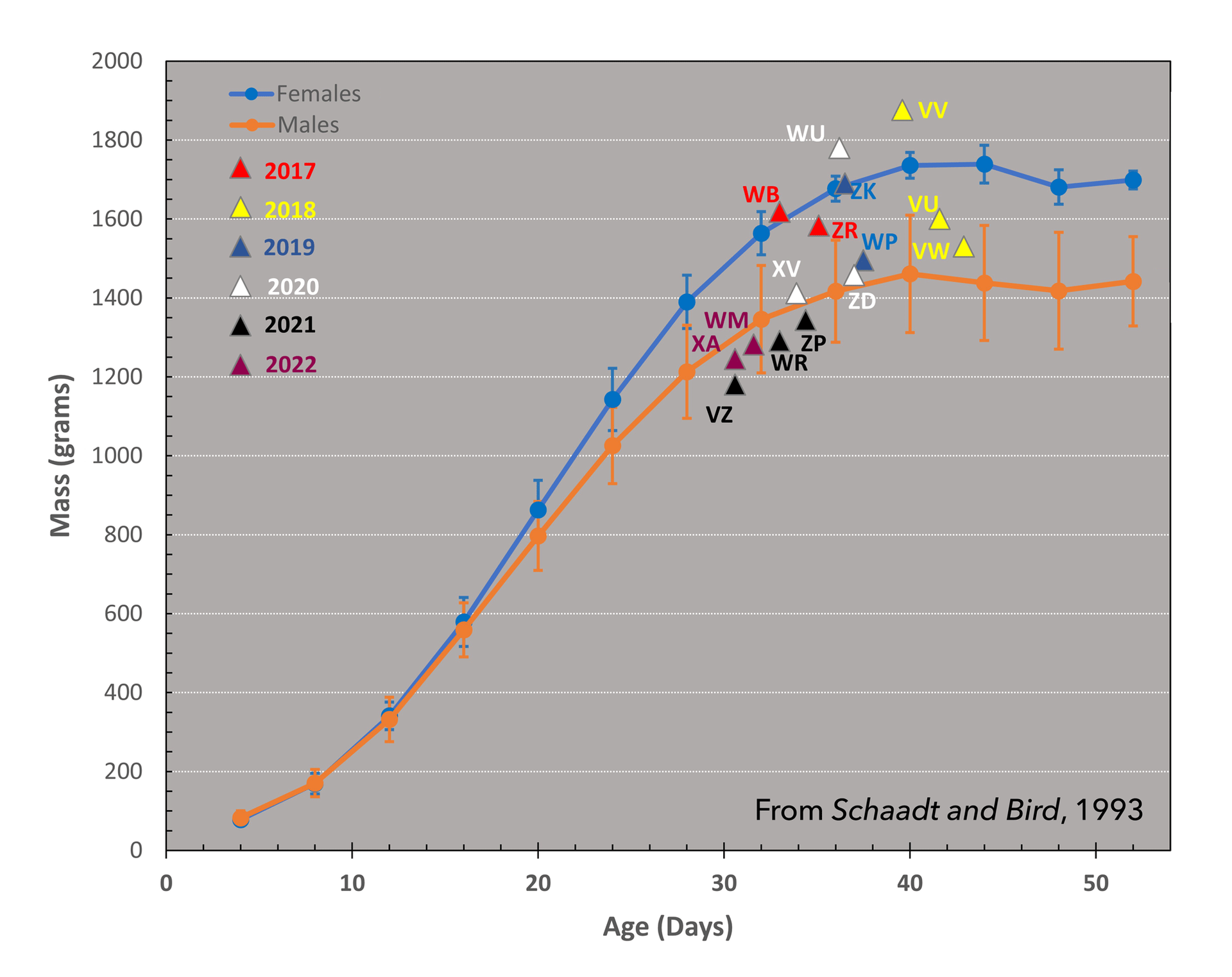
Yes, there is a substantial difference in weight (mass) between male and female Ospreys, as for most raptors. Females are uniformly larger than males. In fact, this is how sex of nestlings is usually determined, although definitive sex determination can be best determined by DNA techniques to detect differences in the sex chromosomes.
It should be noted that unlike in mammals, female birds are heterogametic in having Z and W chromosomes. Males are homogametic with two Z chromosomes.
Due to the rapid growth, hatch order is initially reflected in the size of the nestlings during the early nestling period. Eventually, females may surpass earlier-hatched males in size, or the disparity in size may become greater for earlier-hatched females. Once growing juvenile feathers become prominent, they may confound visual estimation of size. After nestlings have achieved maximal body size (about the same as adults), there is still much feather growth to occur. In fact, flight feather length (retrices/tail, remiges/wing) is incomplete even upon fledging. Also, feather growth rate does not differ between males and females.
Here is a reference paper by Schaadt and Bird describing the results of numerous morphometric measurements of a sizable number of nestlings throughout their development. The same measurements were made on adults. The main data can be found in Figure 1 and Table 4. Some particularly interesting sections have been highlighted.
The data Schaadt and Bird provided—which shows measurements of a substantial number of nestlings throughout the nesting period—was re-plotted, with points added for the weight (mass) of all the nestlings that have been banded at this nest. Values for this nest were then plotted along with age at banding. The values correspond pretty well to either the female or male curves, with only one somewhat equivocal case (VW from 2018). This chart also shows that hatch order does not correspond to size after a few weeks. This nest appears to have little or no food limitation.
What can I do to help Bay Area Ospreys thrive?
There are a number of ways to help Ospreys. Restoring shoreline habitat creates a healthier Bay, with more fish for them to eat. Shoreline land managers can help by installing nest platforms that will provide safe nesting spots, particularly where Ospreys attempt to nest on problematic structures. Ospreys often acquire nesting material from along the shore, and they can and have been entangled by various discarded materials. Recycling fishing line reduces the risk that Ospreys and other marine life will get entangled in improperly discarded line. We all can promote clean and healthy water in the Bay by avoiding the use of pesticides in our yards and by disposing of motor oil and toxic household chemicals at hazardous waste drop-off sites, not in gutters or storm drains. Regular observation of Osprey nests near you may detect nests at risk to disturbance or removal, and Ospreys in need of rescue. Last but not least, you can support our efforts to protect Ospreys and other Bay Area birds by donating to Golden Gate Audubon.
Information about Rosie and Richmond and the Whirley Crane Nest
What is the Whirley Crane?

The Whirley Crane is a historic crane capable of rotating 360 degrees for rapid and highly maneuverable construction and loading of the Victory ships built during World War II in the historic Kaiser shipyards in Richmond, California. While it is no longer used, this Whirley Crane is the best remaining example of its kind, with a boom that is 110 feet long. This Whirley Crane was operated by the famous “Rosie the Riveters” – women who worked in Richmond’s shipyards during the war to build ships for the American Pacific fleet. The nest is above the crane cabin and is about 75 feet off the ground. Learn more by exploring the fascinating historic Richmond shoreline sites, including both the SS Red Oak Victory ship (built by the Rosies) and the Whirley Crane right next to it in Shipyard 3. We also encourage you to visit the Rosie the Riveter WWII Home Front National Historical Park.
How long have Ospreys been nesting on the Whirley Crane? How long have they been nesting in the Bay Area?
There are records of Ospreys nesting at the Whirley Crane site since 2010. Ospreys had long been documented nesting in certain parts of the Bay Area such as Kent Lake in Marin County. The first nesting record along the Bay shoreline was in 1990 in Vallejo, but it’s only since about 2005 that significant numbers have been found nesting along the edge of San Francisco Bay.
When do Rosie and Richmond lay eggs?
Egg laying starts around the begining of April, hatching around the second week of May, fledging early July. Check out this helpful calendar of nesting events.
Nest history
- 2010: First built and used, at least 1 young fledged (data from reliable birder)
- 2011: Failed nesting, Tony Brake’s first observations
- 2012: Male and female both arrived by 3/11/12, fledged 2
- 2013: Male arrived 2/23, female arrived 2/27, fledged 3
- 2014: Male arrived 2/12, female arrived 2/28, fledged 2
- 2015: Male arrived 2/18, female arrived 3/4, failed
- 2016: Male arrived 2/23, female arrived 3/2, fledged 2, Richmond probably nested on RYC, then overwintered in area
- 2017: Richmond overwintered, Rosie arrived 3/5, they first nested together (previous male did not return), fledged 2 (oldest died immediately after fledge). Nest cameras installed by Golden Gate Bird Alliance.
- 2018: Richmond overwintered, Rosie arrived 3/2, fledged 3
- 2019: Richmond overwintered, Rosie arrived 2/23, fledged 2. For San Francisco Bay, 49 actives nests were observed, with 56 young fledged.
- 2020: Richmond overwintered, Rosie arrived 3/5, fledged 3 (youngest died immediately after fledge). For San Francisco Bay, 51 actives nests were observed, with 99 young fledged.
- 2021: Richmond overwintered, Rosie arrived 2/18, fledged 3. For San Francisco Bay, 57 actives nests were observed, with 93 young fledged.
- 2022: Richmond overwintered, Rosie arrived 3/7, fledged 1 (first egg did not hatch, youngest nestling died right before fledging). For San Francisco Bay, 48 actives nests were observed, of these 40 fledged 88 young.
- 2023: Richmond overwintered, Rosie arrived 3/1, two eggs laid five days apart, second egg hatched but nestling died at 5 days of age.
How did you manage to install video cameras at the nest site?

We have two cameras in different spots on the Whirley Crane, each providing different views of the Ospreys and their surroundings. Installing these cameras required many layers of permissions and wonderful cooperation from many partners. We also hired HD camera experts with professional climbing skills, streaming media technologists, and technicians who worked on the crane and used specialized equipment to access portions of the crane.
The cameras are remotely controlled so we will not disturb the Ospreys when adjusting the views. You may notice that you can see what the Ospreys are doing on their nest, even when it’s dark out. That’s because we’re using the cameras in infrared mode to watch the Ospreys, but we are not using any visible light that would disturb the birds at this very sensitive time.
https://goldengateaudubon.org/blog-posts/behind-scenes-osprey-nest-cam/
Fact sheet for Rosie and Richmond
See the fact sheet for the nest since 2017.
Fun Facts
VW Roemer (from 2018) had one talon fall off. Initially noted at banding, it was growing back last seen.
The nest is roughly 4 feet in diameter and is ~75 feet above ground.
Ospreys dive to no more than one meter in depth.
Information about Banding, Ospreys in the Area
Banding Information
Since the Golden Gate Bird Alliance launched this web cam in 2017, Rosie and Richmond’s nestlings have been banded.
The silver bands are issued by USGS Bird Banding Lab to permitted banders, in this case GGRO. They maintain records of all such banded birds. The blue bands are auxiliary bands that require an additional permit from either the US Fish & Wildlife Service or the CA Dept. of Fish & Wildlife. Band sightings can be reported to the BBL at www.reportband.gov, who will respond with information on the banded bird.
GGBA has a blog about the banding process for this nest.
See the fact sheet with banding information for the nest since 2017.
How many Osprey nests are there in the Bay Area?
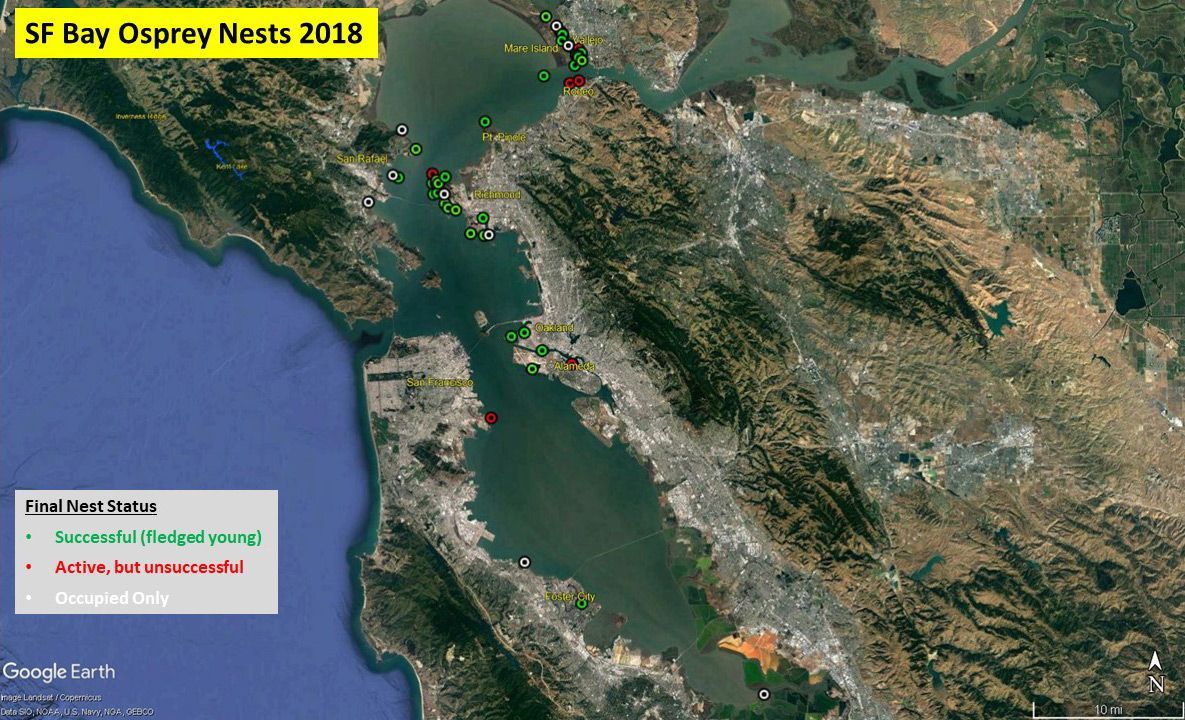
In 2012, there were fewer than 20 nests around San Francisco Bay. There are now over 50 Osprey pairs. In 2022 there were 48 active nests. Of these, 40 successfully fledged 88 young. By 2020, there were over 20 active Osprey nests along the Richmond shoreline alone.
The Richmond Yacht Club platform was erected by RYC members in 2015 for “floaters”. Richmond has been seen in winter on this nest, but it is occupied by other Ospreys during the nesting season.
View Tony Brake’s presentation about Osprey nesting in the Bay Area.
Articles and reports about Ospreys in the San Francisco Bay area
- 2022 Mare Island Osprey Days Presentation A one-hour Zoom presentation by Tony Brake in June, 2022, based on this 2022 presentation.
- 2022 Flyway Festival Presentation A one-hour Zoom presentation by Tony Brake in February, 2022, based on this 2021 presentation.
- An Expanding Osprey Population on San Francisco Bay A one-hour Zoom presentation for Mare Island Osprey Days, July 5, 2020 by Tony Brake
- 2018 Bay Nature Osprey article
- 2018 Update in Pacific Raptor Report published by GGRO
- 2014 Western Birds article on the initial nesting census (2012-2013)
- 2013 Bay Nature Osprey article
The Fish Counting Matrix
At the bottom of the Live Chat page is a record of all observed fish delivered to the nest, as reported by anyone (maybe you!) simply calling “Fish!” on the Live Chat. This information is downloadable for data analysis by anyone, student and scientist alike. Efforts are underway to replicate this system at other Osprey nests to widen our knowledge. Here are a few examples of charts from 2019 put together by the volunteer who logs the fish calls.
Where to Learn More About Ospreys and Other Birds
Links to birding websites where you may find additional information pertaining to your interests.
Visit the Golden Gate Bird Alliance website.
